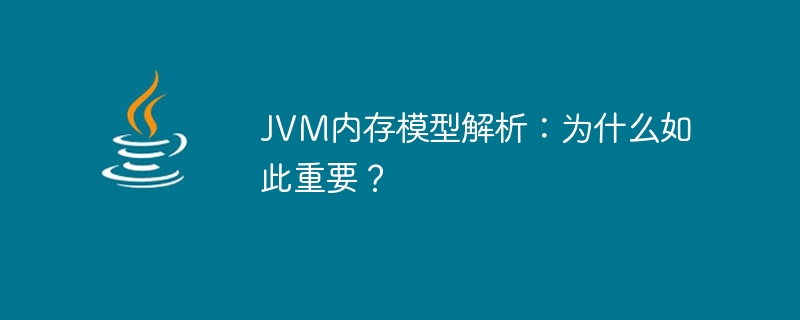

JVM memory model analysis: why is it so important?
In the field of computer science, a Java Virtual Machine (JVM) is a virtual machine capable of running Java bytecode. The JVM memory model is the way the JVM allocates and manages memory at runtime, and is crucial to understanding and optimizing the execution process of Java programs. This article will explore the importance of the JVM memory model and analyze it through specific code examples.
The JVM memory model is divided into two parts: heap memory and stack memory. Heap memory is used to dynamically allocate objects and arrays, while stack memory is used to perform method calls and store local variables. The different characteristics of these two memory models determine their different application scenarios in Java programs.
First of all, heap memory occupies an important position in Java programs. Heap memory is a memory area dynamically allocated by the Java virtual machine at runtime and is used to store object instances and arrays. Since Java is an object-oriented language, objects are created and destroyed very frequently in Java programs. The dynamic allocation mechanism of heap memory provides flexibility and efficiency, making the creation and destruction of objects more convenient. At the same time, heap memory also provides a garbage collection mechanism to automatically recycle objects that are no longer used, reducing the programmer's burden on memory management.
The following is a simple code example that shows the dynamic creation and destruction process of objects in Java:
public class MyClass { private int num; public MyClass(int num) { this.num = num; } public int getNum() { return num; } } public class Main { public static void main(String[] args) { MyClass obj1 = new MyClass(10); // 创建对象 System.out.println(obj1.getNum()); MyClass obj2 = new MyClass(20); // 创建另一个对象 System.out.println(obj2.getNum()); obj1 = null; // 销毁对象 obj2 = null; } }
In the above code, dynamic creation is done through thenewkeyword TwoMyClassobjects are obtained, andnullis used to set them to an invalid state, thereby achieving the purpose of destroying the objects. This process is completely managed by the JVM memory model.
Secondly, stack memory is also an integral part of Java programs. Stack memory is mainly used to execute method calls and store local variables, and has the characteristics of efficiency and independence. Each thread creates a corresponding stack frame when executing a method, which is used to store information such as local variables, method parameters, and operand stacks. The creation and destruction of stack frames is automatically managed by the JVM memory model, making the method calling process safer and more efficient.
The following is a simple code example that shows the process of method calling and stack memory usage in Java:
public class Main { public static void main(String[] args) { int a = 10; // 定义一个局部变量 int b = 20; int sum = add(a, b); // 方法调用 System.out.println("Sum: " + sum); } public static int add(int x, int y) { // 定义一个方法 return x + y; } }
In the above code, themainmethod is defined Two local variablesaandb, and then theaddmethod is called to calculate their sum. When executing theaddmethod, the JVM will create a stack frame for the method to store the parameters passed to the method and the local variables inside the method.
To sum up, the JVM memory model is crucial in the running process of Java programs. By properly managing heap memory and stack memory, JVM provides an efficient, flexible and safe memory allocation and recycling mechanism. A deep understanding of the working principles and characteristics of the JVM memory model will help us write more efficient and optimized Java programs. Therefore, it is crucial for Java developers to understand and master the JVM memory model.
The above is the detailed content of A deep dive into the importance of the JVM memory model. For more information, please follow other related articles on the PHP Chinese website!




